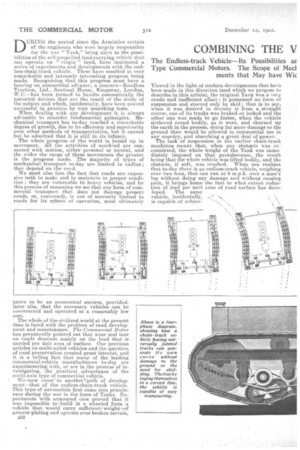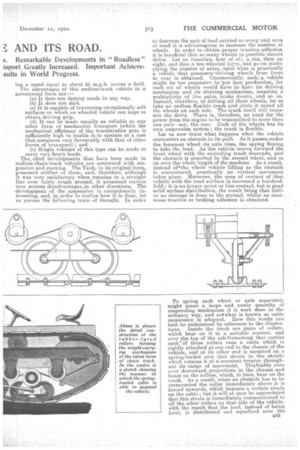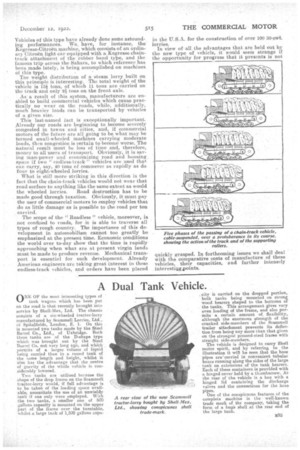COMBINING THE V AND ITS ROAD.
Page 16

Page 17

Page 18

Page 19

If you've noticed an error in this article please click here to report it so we can fix it.
The Endless-track Vehicle—Its Possibilities ar Type Commercial Motors. The Scope of Med ments that May have Wk s. Remarkable Developments in " Roadless " asport Greatly Increased. Important Achievesuits in World Progress.
DURING the period since the Armistice certain of the engineers who were largely responsible for the war "Tank," being alive to the possibilities of the self-propelled load-carrying vehicle that can operate on "virgin " land, have instituted a series of experiments and developments with the endless-chain-track vehicle. Tliee, have resulted in very remarkable and intensely interesting progress being made. Recognizing that this progress must have a bearing on commercial advance, a concern—Roadless Traction, Ltd., Sentinel House, Kingsway, London, W.C.—has been formed to handle commercially the patented devices that are the result of the study of the subject and which, incidentally, have been proved successful in practice by very searching tests.
When dealing with any development it is always advisable to consider fundamental principles. Mechanical transport has to-day reached a remarkable degree of growth, due to its efficiency and superiority over other methods of transportation, but it cannot but be admitted that it is still in its infancy. The whole progress of the world is bound up in movement. All the activities of mankind are connected with motion, either personal or mental, and the wider the range of these movements the greater is the progress made. The majority of types of mechanical transport to-day are limited in radius ; they depend on the road.
We must also face the fact that roads are expensive both to make and to maintain in proper condition; they are vulnerable to heavy vehicles, and by this process of reasoning we see that any form of commercial transport that does not damage present roads, or, conversely-, is not of necessity limited to roads for its sphere, of operation, must ultimately prove to be an economical success, provided. inter alia, that the necessary vehicles can be constructed and operated at a reasonably low cost The whole of the civilized world at the present time is faced with the problem of road development and maintenance. The Commercial Motor has persistently pointed out that wear and tear on roads depends mainly on the load that is carried per unit area of surface. Our previous articles on multi-axled vehicles and the question of road preservation created great interest, and it is a telling fact that many of the leading commercial-vehicle manufacturers to-day are experimenting with, or are in the process of in. vestigating, the practical advantages of the multi-axle type of commercial vehicle.
We ,now come' to anotherpatb of development—that of the endless-chain-track vehicle. This type of automobile first came into prominence during the war in the form of Tanks. Experiments with armoured ears proved that it was impossible to build in a wheeled form a vehicle that. would carry sufficient weight of armour-plating and operate over broken terrain.
B32
Viewed in the light of modern developments that have been made in this direction (and which we propose to describe in this article), the original Tank was a very crude and inefficient affair ; it possessed no form of suspension and steered only by skid ; that is to say,. when it was desired to deviate it from a straight course, one of its tracks was braked or locked and the other one was made to go faster, when the vehicle slithered round bodily, as it were, and churned up the earth in the process, doing far more damage to the ground than would be allowed in commercial use in any country, and absorb in a great deal of power.
The lack of suspension in the earlier chain-track machines meant that, when any obstaicte was encountered, the whole weight of the Tank was immediately imposed on that protuberance, the result being that the whole vehicle was lifted bodily, and the obstacle, if soft, was crushed. Whenone realizes that to-day there is an endless-track vehicle, weighing over two tons, that can run at 8 m.p.h. over a man's leg without doing any damage and without causing pain, it brings home the fact to what extent reduction of load per unit area of road surface has developed. The same vehicle, incidentally, is capable.of aehiev ing a speed equal to about 35 m.p.h. across a field. The advantages of this endless-track vehicle in a commercial form are : (a) It does not destroy roads in any way. (b) It does not skid. (c) It is capable of traversing exceptionally soft surfaces on which no wheeled vehicle can hope to obtain driving grip, (d) It can be matte equally as reliable as any other form of mechanical transport (while the mechanical efficiency of the transmission gear is sufficiently high to enable it to operate at a cost that compares very favourably with that of other forms of transport); and (e) Single vehicles of this type can be made to carry very heavy loads. The chief developments that have been made in endless-chain-track vehicles are concerned with suspension and steering. The Tank, in its original form,. possessed neither of these, and, therefore, although it was very satisfactory when running in a straight line over fairly rough ground, it possessed certain very serious disadvantages,in other directions. The -development of the suspension is exceptionally interesting, and, in order to realize how it is done, let us pursue the following train of thought. In order
to decrease the unit of load carried on every unit area of road it is advantageous to increase the number of wheels. In order to obtain proper tractive adhesion it is beneficial that as many wheels as possible should drive. Let us visualize, first of -all, a six, then au eight, and then a ten-wheeled lorry, and go on multiplying the number of axles, until what is practically a vehicle that possesses =driving wheels from front to rear is obtained.. Commercially, such; a vehicle might be too expensive tout into production, for each set of wheels would have to have its driving mechanism and its steering mechanism, meaning a multiplicity of live axles, brake drums, and so on. Instead, therefore, of driving all these wheels, let us take an endless flexible track and circle it round all the wheels-on each side. The track itself will transmit the drive. There is, therefore, no need for the power from the engine to be transmitted to more than one axle----say, the rear. Each of the wheels has its own suspension system ; the track is flexible.
Let us now trace what happens when the vehicle encounters an obstacle in its path. As it passes under the foremost wheel its axle rises, the spring flexing to take the load. As the vehicle moves forward the front wheel with the encircling track descends, and the obstacle is absorbed by the second wheel, and so on over the whole length of the machine. As a result, instead efithe whole vehicle lifting as the obstacle is encountered, practically no vertical movement takes place. Moreover, the area of contact of that vehicle with the road surface is increased a hundredfold; it is no longer point or line contact, but is good solid surface distribution, the result being that little or no damage is done to the ground, whilst an enormousAractive or braking adhesion is obtained.
To spring each wheel or axle separately might mean a large and costly quantity of suspending mechanism if it were done in the ordinary way, and sotwhat is known as cable suspension is adopted. low this works can best be understood by reference to the illustrations. Inside the track are pairs of rollers, which bear on it in a suitable manner, and over the. top of the sub-framewor,k that carries each' of these rollers runs a cable which is rigidly attached at one end to the chassis of the vehicle, and at its other end is mounted on a spring-loaded arm (not shown in the sketch) which retains it at a constant tension throughout its range of movement. Thistcable runs over downward projections in the chassis and bears on the rollers, which, in turn, bear on the track. As a result, when an obstacle has to be surmounted the roller immediately above it is forced upwards, which imposes a certain strain on the cable ; but it will at once be appreciated that this strain is immediately communicated to all the other rollers on that side of the vehicle, with the result that the load, instead of being local, is distributed and equalized over the
whole surface, the result being that there is a slight increase in pressure per unit of area, but no sharply defined strain on any one portion. Naturally, this reduction of strain brings about lighter mechanism. It is this suspension system that enables the modern " Roadless " vehicle to traverse such exceptionally difficult ground.
By the courtesy of Colonel C. W. Clarke, D.S.O., M.C., of Roadless Traction, Ltd., we were recently privileged to view a film which showed an agricultural tractor and a steam lorry of the latest endless-track types operating over very difficult ground. One of the tests to which the tractor was put was to surmount a heap of freshly cut sawdust. The pile must have been some 20 ft. high, and its side had a slope
of, approximately, 1 in 3, so far as could be judged by the eye. It was difficult for a man to walk up the pile, for his feet sank into it and, the loose particles fell away like drifted sand. The tractor not only climbed the pile easily, but made surprisingly little disturbance of the sawdust in the process. It also was brought to a standstill on the 1-in-3 slope without difficulty, which shows that, providing a load can be spread over a sufficiently large area, almost any type of ground can be negotiated.
We saw the tractor hauling a two-toneak log across soft ground, in portions of which it was possible to push a cane walking-stick up to its hilt without difficulty, and where deep bootmarks were left by pedestrians. The steam lorry was shown operating in a ploughed field which had been drenched by a thunderstorm but two hours previously ; it was carrying a sixton load, and ran evenly and without a suspicion of trouble, and; what was as striking, left. very little sign of its passage in its wake. In contrast was the jperformance in 4,he same field .of an ordinary four'wheeled steamer that was not' .carrying any load. Hardly had it touched the stubble . than its rear wheels began to spin, and gradually they dug themselves in until further progress was impossible. A triumph for the endless track vehicle was amply demonstrated by the way it hauled the bogged " wheeler " -and • its own load round the field and even up a slight gradient. It is very noticeable that when one of these flexible chain-track machines passes over uneven ground that is fairly soft no well-defined rut is left in its wake. Now, it is obvious that to form a rut of. any kind means that a certain amount of energy has to be expended. In the ease of a wheeled cart or lorry the softer the groued the deener is the rut, and the. more power is absorbed by the propulsion of the vehicle. In other words, the nature of the rut left can be taken as a measure of the mechanical efficiency of the load-carrying system. The fact that the cable-sprung endless-track vehicle loaves practically no mark shows that no undue amount of power is being taken to drive over the ground, and this makes the endlesschain-track system particularly well adapted for use on load-carrying trailers that are drawn by any form of vehicle when soft ground has to be negotiated.
A further interesting development of the cablesuspension system referred to above is illustrated in the five-phase diagrams reproduced on these pages. Instead of having a singie cable, the wear knot strain) on which of necessity is localized, an endlesscable system has been adopted. As the rollers and the track move up and down when they absorb road inequalities, they automatically . bring into position a new length of cable, so that there is no fear of wear taking place at any particular point, which thus renders the system immune from possible breakdown. In another design a, chain is used instead of a cable, in order to prolong the life of this component, but fundamentally the systems are the same. We can now turn to the question of steering. So long as an endless track is not flexible laterally, any vehicle equipped on this system must of necessity churn up earth when turning corners. This is not so great a disadvantage as might 'be thought at first sight in vehicles of a certain type. For instance, a farm tractor, if it be used for ploughing, should be capable of turning in its own length at the headlands. No ordinary wheeled tractor can hope to do this ; but it has been found that by locking one track of a rigid track " Boadless " and transmitting all the power on to the other, a vehicle of this type slews round, as it were, practically in its own length, and, as )tests have demonstrated, it 4oes so without causing a great deal of damage to the soft ground., Such methods, however, would certainly not be satisfactory on load-carrying vehicles, and so a very clever form of steering has been developed.
The latest form of track is universally flexible ; it consists of large flat, feetlike plates coupled together by ball joints so that relative angular motion in any direction between the plates can be obtained. By the use of the cable suspension lateral motion of the rollers which bear on the track is made possible, and, as a result, when any change of direction is desired one track is braked, and the plates of the tracks actually lay themselves in a generated curve, and at no time is there relative motion between them and the ground with which they are in contact, providins, of course, that the radius of the turn is not sufficiently small to cause skidding. The degree of "lock," as it may be termed, however, has been found to be ample for most purposes, particularly with what is known as the " half-track " type of vehicle.
It would appear reasonable to suppose that the half-track vehicle is a type which will first be developed largely, and present tendencies show this to be the case. It consists mainly of an ordinary chassis with the front axle and steering gear left in situ, hut with the back axle replaced with an endless track. Vehicles of this type have already done sonde astounding performances. 'We, have, for instance, the Kegresse-Citroen machine, which consists of an ordinary Citroen light car equipped with a Kegresse chaintrack attachnient of the rubber band type, and the famous trip across the Sahara, to which reference has been made lately, is being accomplished on machines of this type. The weight distribution of a steam lorry built on this principle is interesting. The total weight of the vehicle is 131 tons, of which 11 tons are carried on the track and only 21 tons on the front axle.
As a result of this system, manufacturers are enabled to build eon-menial vehicles which cause practically no wear on the roads, while, additionally, much heavier loads can be transported by vehicles of a given size.
This last-named fact is exceptionally important. Already our roads are beginning to become severely 'congested in towns and cities, and, if commercial motors of the future are all going to be what may be termed small-wheeled machines carrying moderate loads, then congestion is certain to become worse. The natural result must be loss of time and, therefore, money to all users of transport. Obviously, it is saving man-power and economizing road and housing space if two " endless-track" vehicles are used that can carry, say, 40 tons of commerce as rapidly as do four to eight-wheeled lorries.
What is still more striking in this direction is the fact that the chain-track vehicles would not wear that road surface to anything like the same extent as would the wheeled lorries. Road destruction has to be made good through taxation. Obviously, it must pay the user of commercial motors to employ vehicles that do as little damage as is possible to the road per ton carried.
The scope of the " Roadless " vehicle, moreover, is not confined to roads, for -it is able to traverse all types of rough country. The importance of this development in autornobilism cannot too greatly be emphasized at the present time. Econemic conditions the world over to-day show that the time is rapidly approaching when what are at present virgin lands must be made to produce revenue. Mechanical transport is essential for such development. Already American engineers are taking great interest in these endless-track vehicles, and orders have been placed in the U.S.A. for the construction of over 100 30-cwt. lorries.
In view of all the advantages that are held Out by the new type of vehicle, it would seem strange if the opportunity for progress that it presents is not quickly grasped. In forthcoming issues we shall deal with the comparative costs of manufacture of these vehicles, their capacities, and further intensely interesting points.






























